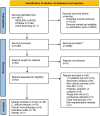Causal role of the gut microbiome in certain human diseases: a narrative review
- PMID: 39944364
- PMCID: PMC11770457
- DOI: 10.1136/egastro-2024-100086
Causal role of the gut microbiome in certain human diseases: a narrative review
Abstract
Composed of an elaborate ecosystem of bacteria, fungi, viruses and protozoa residing in the human digestive tract, the gut microbiome influences metabolism, immune modulation, bile acid homeostasis and host defence. Through observational and preclinical data, the gut microbiome has been implicated in the pathogenesis of a spectrum of chronic diseases ranging from psychiatric to gastrointestinal in nature. Until recently, the lack of unequivocal evidence supporting a causal link between gut microbiome and human health outcomes incited controversy regarding its significance. However, recent randomised controlled trial (RCT) evidence in conditions, such as Clostridioides difficile infection, cancer immunotherapy and ulcerative colitis, has supported a causal relationship and has underscored the potential of the microbiome as a therapeutic target. This review delineates the RCT evidence substantiating the potential for a causal relationship between the gut microbiome and human health outcomes, the seminal observational evidence that preceded these RCTs and the remaining knowledge gaps.
Keywords: Gastrointestinal Microbiome; Intestinal Microbiota; Ulcerative Colitis.
Copyright © Author(s) (or their employer(s)) 2024. Re-use permitted under CC BY-NC. No commercial re-use. See rights and permissions. Published by BMJ.
Conflict of interest statement
JP reports grants from MedImmune, grants and personal fees from Merck and personal fees from AstraZeneca, all outside the submitted work. TCL has operating grants from the CIHR and receives salary support from the Fonds de Recherche du Québec—Santé outside of this work. HS is the cofounder and chief technical officer of Kanvas Biosciences and owns equity in the company. PB is the chief scientific officer of Kanvas Biosciences. LS is the chief development officer of Kanvas Biosciences. BR has received grant funding from Davolterra and Kanvas and honoraria from Merck, BMS and AstraZeneca and is the cofounder of Curebiota. CPY reports being on an independent data monitoring committee for Medicago. MPC reports operating grants from the Canadian Institutes of Health Research during the conduct of the study and salary support from the Fonds de Recherche du Québec—Santé, both unrelated to this work; personal fees from GEn1E Lifesciences and Nomic Bio as a member of the scientific advisory board; personal fees from AstraZeneca as a scientific consultant; research support from Cidara Therapeutics, Scynexis and Amplyx Pharmaceutics during the conduct of the study but outside the submitted work; is the cofounder of Kanvas Biosciences and owns equity in the company; and has pending patents, including: (1) methods for detecting tissue damage, graft-versus-host disease and infections using cell-free DNA profiling, (2) methods for assessing the severity and progression of SARS-CoV-2 infections using cell-free DNA pending and (3) rapid identification of antimicrobial resistance and other microbial phenotypes using highly multiplexed fluorescence in situ hybridisation. The other authors declare no conflicts of interest.
Figures
References
Publication types
LinkOut - more resources
Full Text Sources


